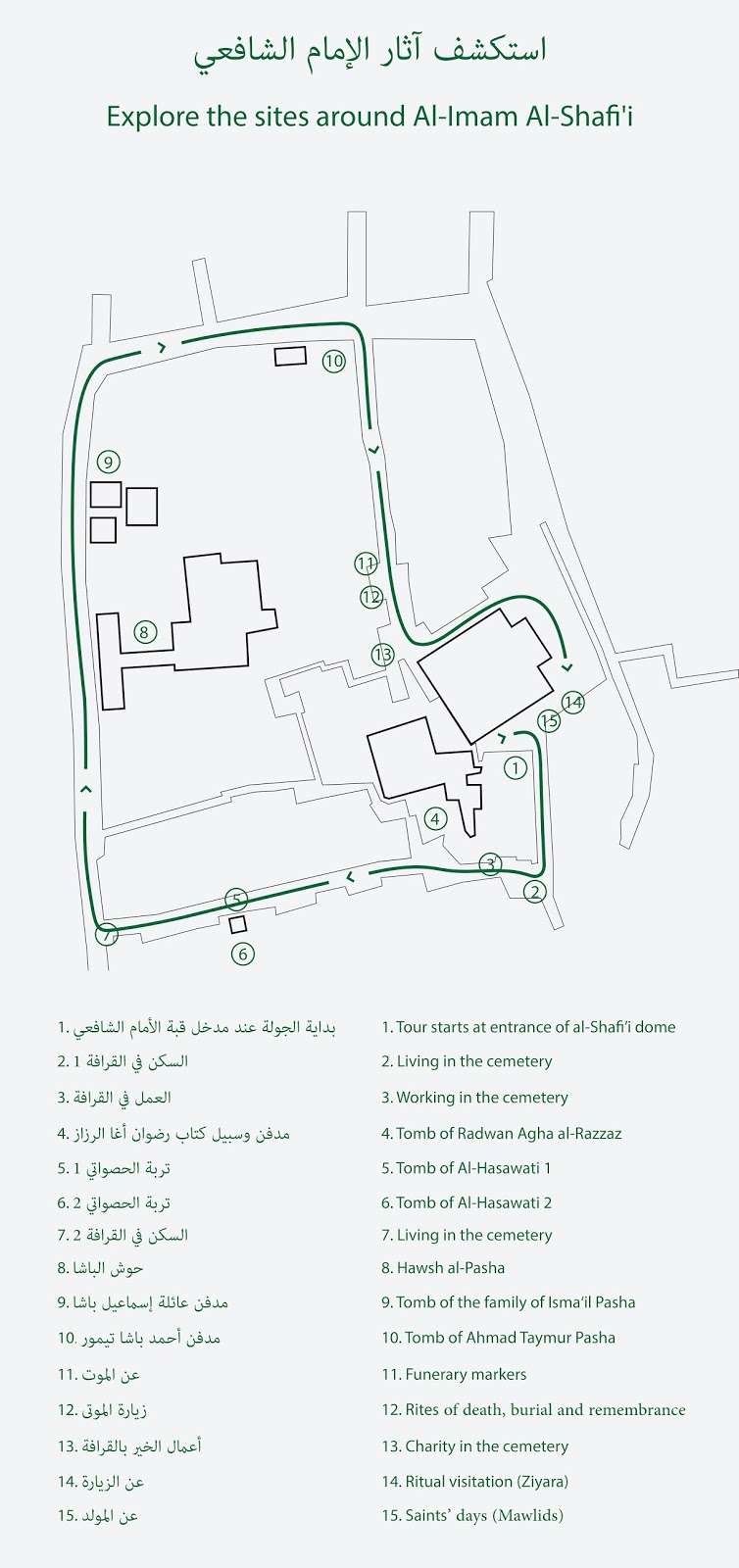مراسم الدفن / Rites of burial
الجنازة والدفن
يَومَ القِيامَةِ لا مالٌ وَلا وَلَدٌ وَضَمَّةُ القَبرِ تُنسي لَيلَةَ العُرسِ(الأمام الشافعي)
يَومَ القِيامَةِ لا مالٌ وَلا وَلَدٌ وَضَمَّةُ القَبرِ تُنسي لَيلَةَ العُرسِ(الأمام الشافعي)
بعد الموت والتغسيل والتكفين تبدأ الجنازة حيث يؤخذ الفقيد للمسجد لصلاة الجنازة ثم للقرافة للدفن. وتعتبر سرعة سير الجنازة لخفة النعش فألًا طيبًا يبشر بدخول الفقيد الجنة. جميع طقوس الجنازة تتم نهاراً بين الشروق والغروب.
العزاء
ذهب الذين يقال عند فراقهم ليت البلاد بأهلها تتصدع (محمد بن عاصم المعافري)
ليس من المعتاد أن يتم قبول العزاء بالقرافة. في الشريعة الإسلامية تقتصر فترة على ثلاثة أيام إلا أن المعتاد في مصر أن تمتد فترة الحداد أربعين يوماً وحرص أهل المتوفي على زيارة قبرة أسبوعيًا أيام الجمعة طوال هذه الفترة.
الزيارة
ولما أتينا قبره لنزوره عرفناه لما فاح طيب تراب (بيت شعر على أحد القبور دونه شمس الدين بن الزيات)
اعتاد المصريون على زيارة مزتاهم دوريًا خصوصا أيام الجمعة وخلال الأعياد والاحتفالات الدينية وكذلك يوم السنوية. ونجد بوقفيات العصر المملوكي مصاريف لطقوس الزيارة مثل قراءة ورد أو جزء من القرآن ووضع الخوص والريحان على القبر وتوزيع الخيرات مثل الماء والقرص. أما الزيارات أيام الأعياد والاحتفالات الدينية فتتنوع مظاهر الاحتفال لتشمل إنارة المقابر وذبح الأضحية وتلاوة القرآن لفترات أطول والمبيت ليلًا بالمقابر أو بالخيام المنصوبة خصيصًا لهذا الغرض. وكانت القرافة تزدحم بالزوار أيام العيدين وعاشوراء ومنتصف شعبان والمولد النبوي الشريف.
لمزيد من المعلومات عن تطور طقوس الجنازة من العصر المملوكي للعصر الحالي إضغط هنا:
Burial
Afte death, the body is washed and shrouded at home or in a lavatory. The funerary procession then starts. The body is taken for funerary prayer then to the cemetery for burial. It is believed that the faster the funerary procession and the lighter the bier, the more virtuous the deceased and the likelier s/he is headed to heaven. All rites of death and burial have to take place between sunrise and sunset.
Condolence
The ritual of condolence (`azá'), where the family of the deceased gather to accept condolences was not commonly held in the cemetery. The Islamic period of mourning is three days, but it is customary to observe forty days of mourning and the bereaved may continue to return to the cemetery every Friday until the forty days are over.
Visitation
Periodical visits to the dead are customary. Certain days such as Fridays and religious holidays are especially popular as is the annual anniversary of death. Endowment deeds from the Mamluk period onwards allocated funds for religious observances such as hiring a qari' to recite a set section of the Quran or of religious poetry, laying basil and palm frond on the grave, and distributing water and bread for charity. Visits during religious holidays involved more preparation, with lights, longer religious recitals, ritual slaughter of animals and staying overnight in tombs or tents. The two Eids were the most crowded among days of visitation as well as ‘Ashura’, mid Sha`ban and Mawlid al-Nabi.
Click here for an account of funerary rituals from the Mamluk period onwards
Click here for an account of funerary rituals from the Mamluk period onwards

